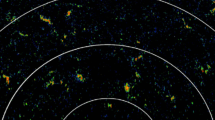Abstract
Observations of the first major active regions and large-scale magnetic field patterns of Cycle 22 are presented. These show that, following the emergence of a trans-equatorial pattern, or cell, of positive flux related to old cycle activity, the first new cycle active regions of the longitude range emerged across the neutral lines of this cell, which continued to grow and expand across the equator for several rotations. The development of a parallel trans-equatorial band of flux of opposite (negative) polarity and the emergence of both new and old cycle active regions across a neutral line of this cell are also described.
Simulations using the flux transport equation, and based on synoptic magnetic data provided by the Mount Wilson Observatory, show that, while the growth of the positive region could, in part, be explained by the decay of flux from these new regions, there were significant differences between synoptic contour charts based on the simulations and those constructed from the observed fields. They also show that the development of the negative region cannot reasonably be explained by the decay of the observed active regions.
A further example of the counter rotation of decaying active region fields is reported. Here the initial tilt of the negative-positive magnetic axes of two adjacent regions is normal, and simulations based on these data show their combined follower flux moving preferentially polewards. However, the observations show that, after three rotations, the decaying leader flux is entirely poleward of the follower flux.
Similar content being viewed by others
References
Cannon, A. T. and Marquette, W. H.: 1991, Solar Phys. 131, 69.
De Vore, C. R. and Sheeley, N. R., Jr.: 1987, Solar Phys. 108, 47.
De Vore, C. R., Sheeley, N. R., Jr., and Boris, J. P.: 1984, Solar Phys. 92, 1.
Leighton, R. B.: 1964, Astrophys. J. 140, 1547.
Marquette, W. H. and Martin, S. F.: 1988, Solar Phys. 117, 227.
McIntosh, P. S. and Wilson, P. R.: 1985, Solar Phys. 97, 59.
Schrijver, C. J. and Martin, S. F.: 1990, Solar Phys. 129, 83.
Sheeley, N. R., Jr., Nash, A. G., and Wang, Y.-M.: 1987, Astrophys. J. 319, 481.
Snodgrass, H. B.: 1983, Astrophys. J. 270, 288.
Stenflo, J. O.: 1990, in A. van Alvensleben (ed.), JOSO Annual Report.
Wang, Y.-M., Nash, A. G., and Sheeley, N. R., Jr.: 1989, Science 245, 681.
Wilson, P. R. and McIntosh, P. S.: 1991, Solar Phys. 136, 221 (Paper II).
Wilson, P. R., McIntosh, P. S., and Snodgrass, H. B.: 1990, Solar Phys. 127, 1 (Paper I).
Author information
Authors and Affiliations
Additional information
On leave from the School of Mathematics, University of Sydney.
Rights and permissions
About this article
Cite this article
Wilson, P.R. The reversal of the solar polar magnetic fields. Sol Phys 138, 11–21 (1992). https://doi.org/10.1007/BF00146193
Received:
Revised:
Issue Date:
DOI: https://doi.org/10.1007/BF00146193




